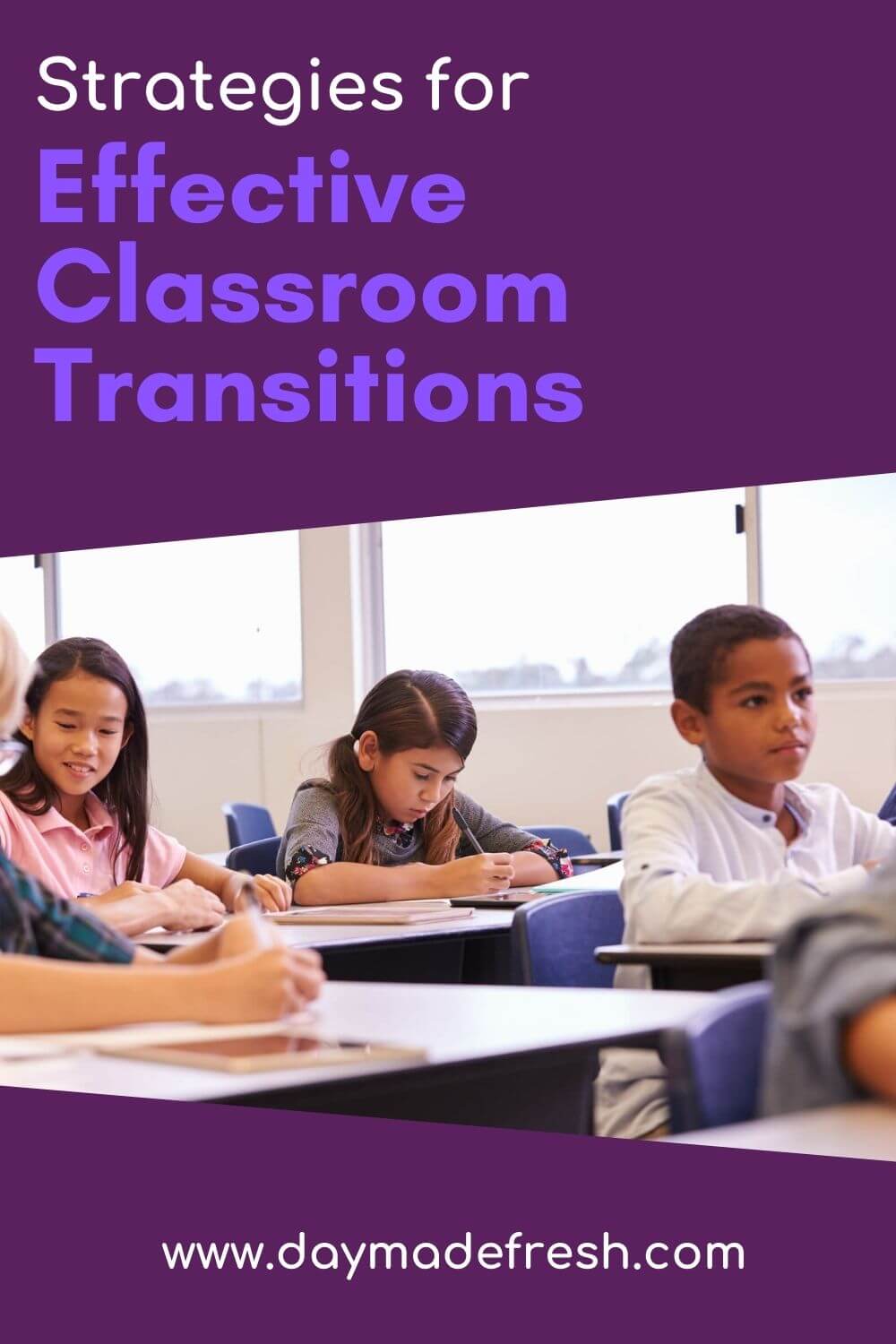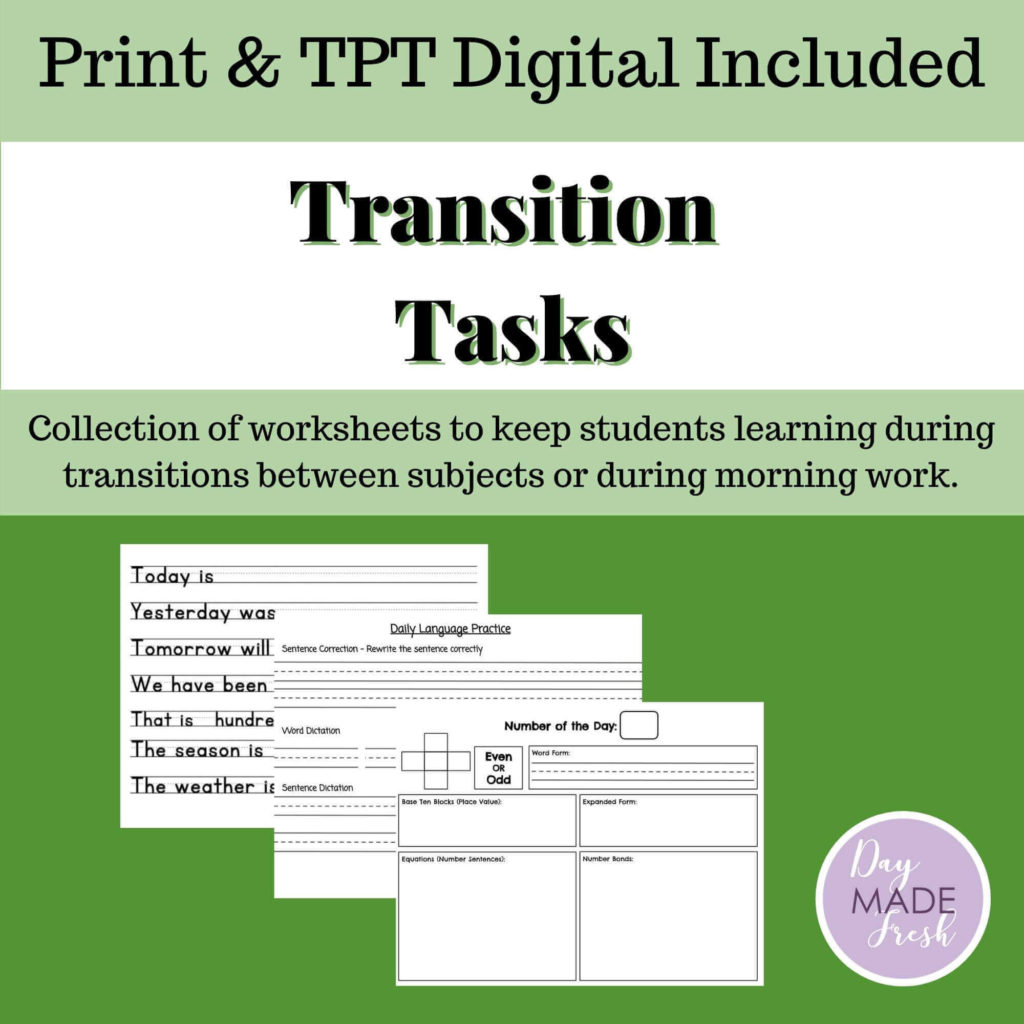How do your classroom transitions go? Are they smooth and productive or do they cut into your instructional time? Classroom transitions have a large impact on the day-to-day success of your classroom routines. As well as the amount of time students spend learning in an elementary classroom.
Effective or productive elementary classroom transitions do not mean that your classroom has to become regimented. It also doesn’t have to mean that students don’t get a chance to take a break. Instead, a good classroom daily routine with smooth transitions allows you to maximize learning time. Using time efficiently allows you to make time for students to take much-needed breaks.
When classroom transitions are rough and rowdy valuable time gets spent bringing students back and ready to learn. This creates a sense of chaos and stress for us as educators and for our students.
If we’re always trying to rein students back in it can create a negative relationship with them. In my experience, behavior problems often pop up during transition times. Causing even more issues and losing more time.
On the other hand, when you’re able to smoothly move from one subject to the next less time is wasted and the atmosphere is more relaxed. Students, especially elementary students thrive on predictability. By teaching them how to efficiently switch from one activity to the next they know what to expect. Also, when time is used more effectively you can give students more breaks.
This post contains some affiliate links for your convenience. Click here to read my full disclosure policy.
Keep students productive using these strategies for smooth transitions in your elementary classroom
Some strategies to help with smooth classroom transitions include transition tasks, movement breaks, and structured downtime. Like any new thing developing smooth transitions takes time and a lot of practice.

Transition Tasks
One of the best ways to make the most of transition periods is to incorporate transition tasks into your daily schedule. A transition task is an activity that can be done between subjects or after required work. It should be something that students can do without adult assistance. An ideal transition task also helps students review skills or extend their learning.
An easy transition task to add to your routine is having students work on an online learning website. Most of these types of programs are developed for students to complete independently. Some even offer differentiated learning. They can adjust to each student’s individual skills depending on if they need reteaching or enrichment. If you’re looking for an online learning website this list of reviews for personalized learning tools from Common Sense Education is a great place to start.
A non-screen option is to create a set of reusable worksheets. To do this put worksheets into clear sheet protectors. Then add these to a 3-pronged folder or 3-ring binder. Students can then use a dry erase marker to complete the worksheets. This means you don’t have to worry about constantly making copies and the transition task will be readily available.
For these reusable worksheets to work students need to be able to do them independently. This does require a little front-loading modeling how to complete the tasks. To not overwhelm students go over one task at a time. Once students are comfortable with each task you can add another.
Movement Breaks
Movement breaks are a great option during transitions especially if you have a group of students that need to get their energy out. In my experience, the younger the students the more movement breaks they need. Students often need more movement breaks when they’ve been on long breaks from school.
While students aren’t working on academics during movement breaks they are beneficial to their learning. Movement breaks can help students refocus and prepare their brains for learning. Curious about the benefits of movement breaks? Read this article from Responsive Classroom: Movement Breaks to the Rescue!
My favorite tool for movement breaks is GoNoodle. I have used GoNoodle since 2012 with kindergarten thru third-grade students. GoNoodle offers a variety of guided movement breaks that include calming activities, mindfulness, guided dance, and so many more. They even have movement breaks that connect to academic skills.
GoNoodle RESEARCH: Why Clasrooms Need Movement Everyday
Want to limit screen time for your students? Have students stand and stretch by their desks. This takes only a little time and gives students all the benefits of a movement break. This type of movement break is great when you notice students losing attention, but don’t only have a few minutes.
Structured Downtime
Students crave downtime and time to talk to their peers. The only problem is that this can easily get out of control and it can be hard to get students back on track. Giving students parameters such as a set of expectations and a time limit can help prevent this.
Suggested Expectations
- Keep topics school appropriate
- Talk to the people around you
- No moving around the room
The goal with structured downtime is to make the transition back to instructional time easier. Keeping the time structured can also help prevent bullying or other destructive behavior.
This option isn’t one I would suggest using too frequently. It loses the special quality if you use it too often. I would also not recommend using this transition activity if you have a class with behavior issues. You know your students best and if they struggle with downtime there are other options that will better fit your needs. Students already have downtime during lunch and recess, so it will be ok if they don’t get it in class.
Other TIps
- Link bathroom breaks to transition times. Students that are not taking a bathroom break can be doing a movement break or transition task. Whole class bathroom breaks with students waiting in a line is, in my opinion, a waste of instructional time.
- Post transition time expectations. To further help prevent negative student behaviors and encourage student independence have a set of expectations for students during each type of transition activity.
- Make smooth, quick transitions a game. Want to shorten the time it takes to transition students from one activity to another? Time how long it takes students to move from the transition task to be prepared to learn. Then try to have them beat that time.
- Reward students that have successful transitions. If you use a program like ClassDojo you can create a positive skill for smooth transitions. Then reward students for demonstrating the desired behaviors of a smooth transition.
RELATED POST: Why You Need a Classroom Management Plan
Transitions can be productive and a positive part of your school day. This can be accomplished by having a clear plan and a transition activity for each transition period. Then model the expectations for each activity and give students time to practice. Once your class has a set of transition activities and they’ve built up their independence you can keep your students moving, grooving, and learning during transitions.
Ready to create more efficient transitions in your class? Which activity will you incorporate into your class’s daily routine?
Click now to purchase a set of reusable transition task worksheets. They’re ready to print, easy to use, and cover a variety of skills!
I’m not ready to purchase, but I’d love a set of FREE Classroom Management Checklists!

